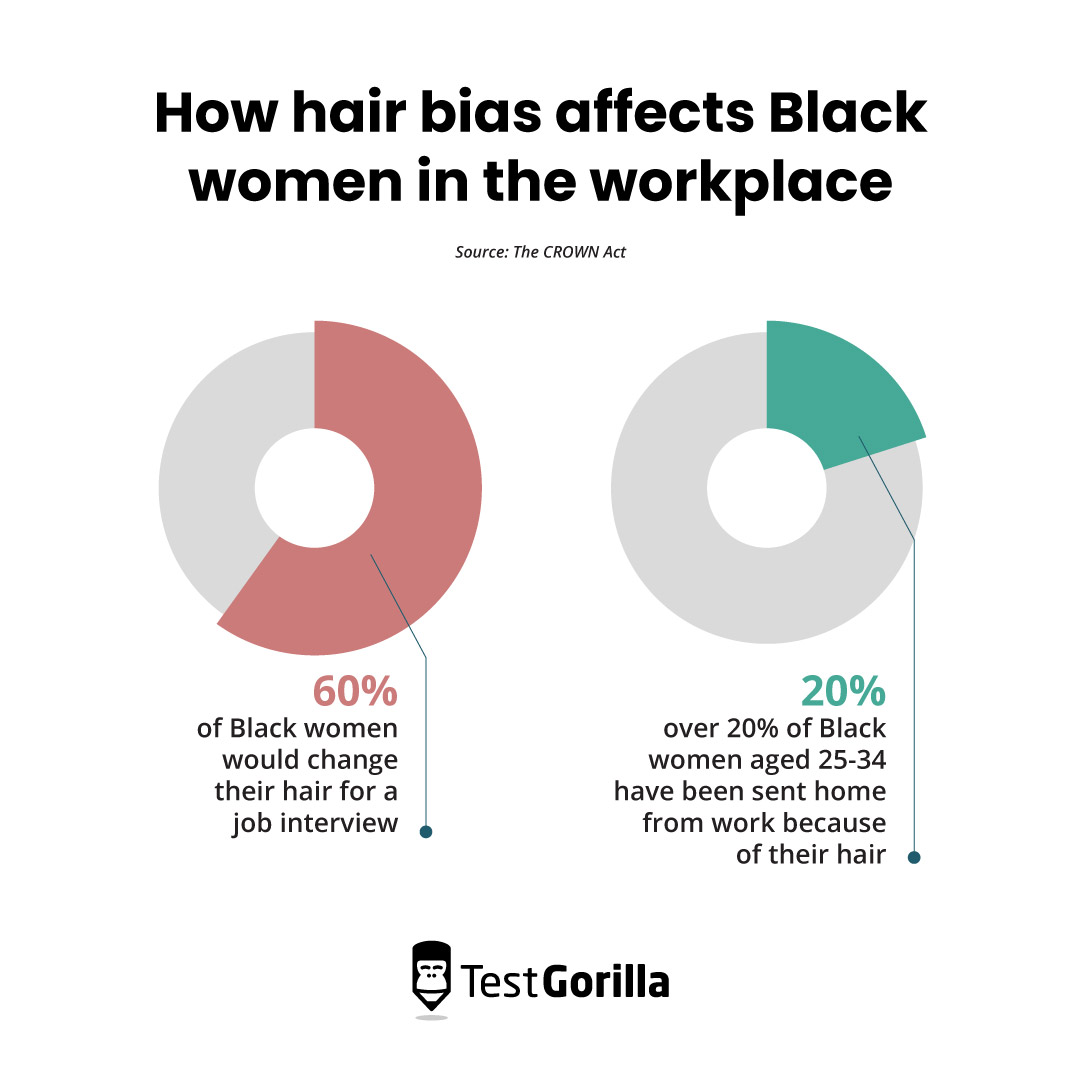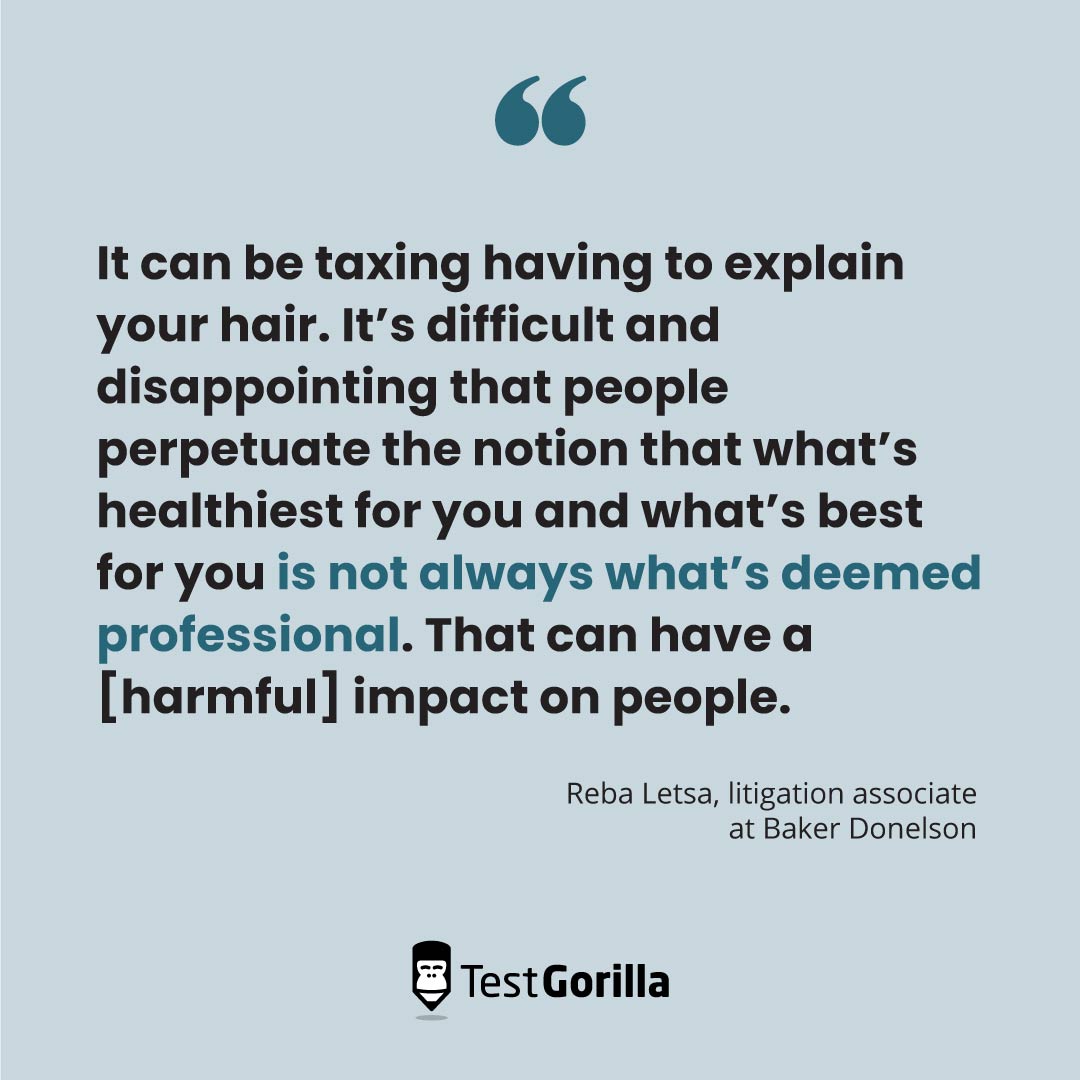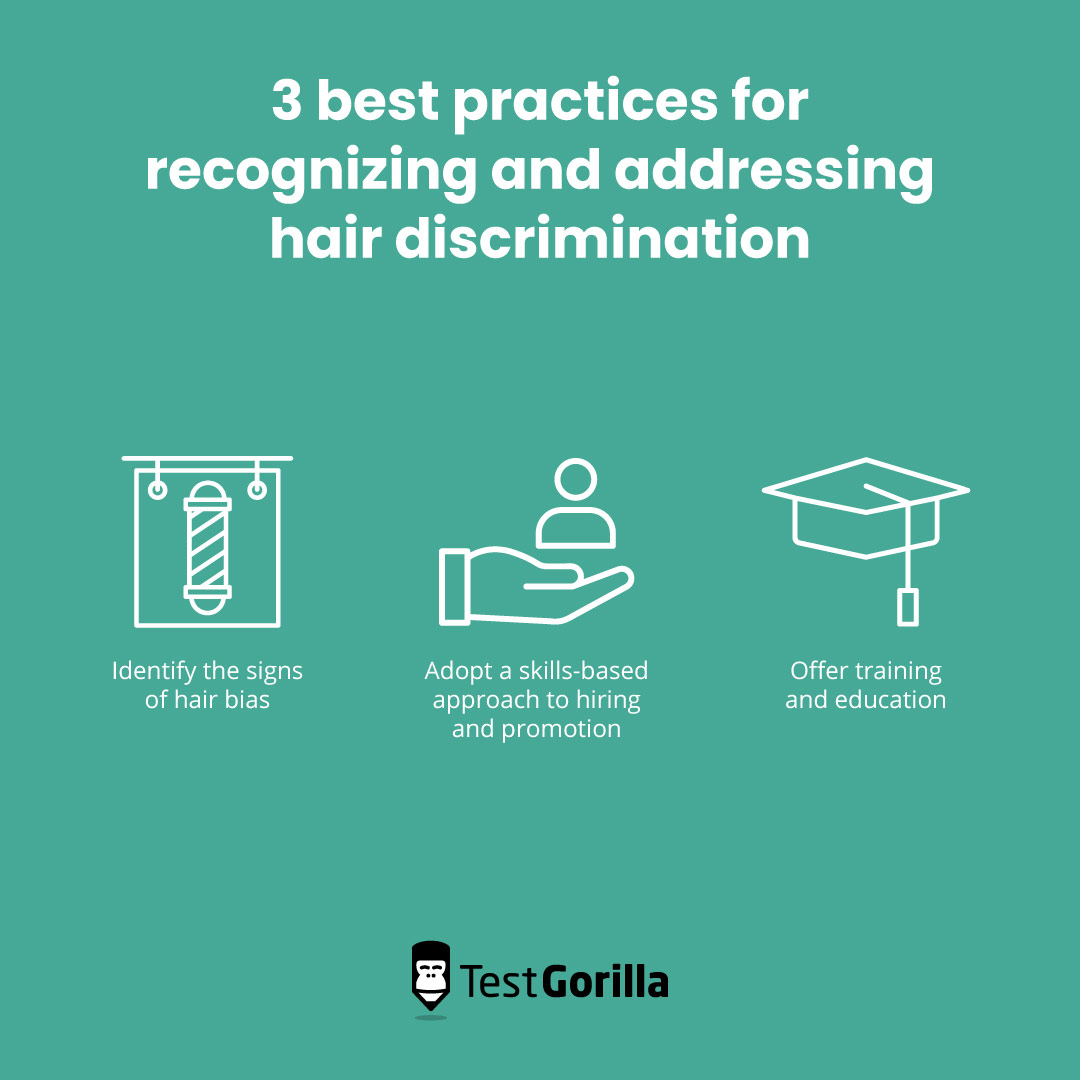Don’t touch my hair: How hair bias affects Black women in the workplace
Hair discrimination remains a widespread issue for Black women in the workplace with a 2023 CROWN Workplace Research Study finding that Black women’s hair is 2.5x more likely to be perceived as unprofessional.[1]
Sixty-six percent of Black women would change their hair for a job interview, and over 20% of Black women aged 25-34 have been sent home from work because of their hair.
In this article, we look at the societal causes and detrimental effects of hair discrimination on Black women in the workplace. From biased perceptions to unfair policies, we’ll explore the challenges they face and why it's time to address this issue head-on.
You’ll also read about some best practices designed to tackle hair bias and how a skills-based approach to hiring and promotion can help reduce unconscious bias and lead to a more diverse and inclusive workplace.
Table of contents
- What is hair discrimination?
- How hair discrimination manifests itself in the workplace
- The impact of hair discrimination on Black women
- Legislating for change: The CROWN Act
- 3 best practices for recognizing and addressing hair discrimination
- Hair today, gone tomorrow: Eliminate hair discrimination for a more inclusive workplace
What is hair discrimination?
Hair discrimination refers to the prejudiced treatment based on natural hairstyles and hair textures commonly associated with Black and African-descendant communities. Such discrimination manifests in various settings, from schools to workplaces, and social environments.
Individuals with afros, braids, twists, bantu knots, locs, or other culturally significant and protective hairstyles face discriminatory practices that unfairly target their appearance.
Historically, Eurocentric beauty standards have perpetuated biases against diverse hair types, promoting a preference for straight hair while deeming curly, coily, or voluminous hair as "unprofessional" or "unkempt."
As a result, Black individuals, especially women and feminine-presenting people, have been subjected to discriminatory policies, like school dress codes and bias in employment practices. These policies amplify barriers to entry and keep Black individuals from accessing the educational and career opportunities they deserve.
How hair discrimination manifests itself in the workplace
Hair discrimination can take various forms, not all of which are overt and explicit. In many instances, it can be more implicit and unconscious, rooted in deeply ingrained societal biases and beauty standards.
While progress is being made, several high-profile cases in the US and UK show that hair discrimination and texturism (discrimination against people with coarser hair within the same race) are still all too common.
For example, as Reba Letsa, litigation associate at Baker Donelson illustrates in The CROWN: Anti-Hairstyle Discrimination Legislation Protecting Natural Hairstyles in the Workplace, US high school wrestler Andrew Johnson was given 90 seconds by a White referee to either cut his dreadlocks or forfeit the match altogether.[2] The crowd watched as a school official cut Andrew’s hair.[3]
Ruby Williams, a student of Urswick school in East London, was repeatedly sent home from school because of her afro, which teachers found to be against the school’s dress code.[4] Another school in Birmingham, England, banned a student from the school cafeteria and playground due to her braided hairstyle.[5]
Even Michelle Obama reported straightening her hair during her time in the White House. “As first lady,” she says, “I did not wear braids. I thought about it, but I thought, ‘no, they’re not ready.’” She believed her natural hair would distract the public from her and her husband’s policies and efforts to make change.[6]
When talking about starting a prestigious summer associate position in 2018, Reba said, “That summer, I had braids in. I did have these internal conversations about whether or not it would be appropriate [to keep them] or whether I would be judged. No one made me feel like [I had to], but based on my previous experiences in life, I decided to take them out.”
“I know that while everyone might have good intentions, there are inherent prejudices and biases that can surface… I just wanted to be judged on my work. And I think a big part of it was [societal] conditioning and growing up in the world where there was just one beauty standard elevated in the media and the news and you didn't see people with braids uplifted in the same way.” – Reba Letsa, litigation associate at Baker Donelson.
The best insights on HR and recruitment, delivered to your inbox.
Biweekly updates. No spam. Unsubscribe any time.
The impact of hair discrimination on Black women
Hair discrimination can often negatively impact a person’s self-esteem and psychological well-being and safety.
Black individuals may feel compelled to alter their natural hair, which for many is a large part of their identity, just to assimilate into spaces that enforce unjust norms.
“It can be taxing having to explain your hair,” Reba says. “It’s difficult and disappointing that people perpetuate the notion that what’s healthiest for you and what’s best for you is not always what’s deemed professional. That can have a [harmful] impact on people.”
Implicit biases can also be observed in subtle behaviors, microaggressions, or assumptions about individuals based on their natural hair. For example, comments like "Your hair looks so exotic" or "Can I touch your hair?" may seem harmless to some. However, they can contribute to a sense of otherness and objectification, making Black individuals feel like their hair is a curiosity and a distraction rather than a normal expression of their identity and cultural heritage.
Such biases can also influence hiring decisions or promotion opportunities, where individuals with natural Black hairstyles might be unconsciously perceived as less professional or less suitable for certain roles. For example, CROWN’s Workplace Research Study found that:
Black women’s hair is 2.5 times more likely to be perceived as unprofessional
Black women are 54% more likely to feel like they need to straighten their hair for a job interview to be successful
Recognizing the significance of this issue, some states in the US have taken steps to enact change and combat hair discrimination. Let’s take a look at those next.
Legislating for change: The CROWN Act
The 2022 Act Creating a Respectful and Open World for Natural Hair (CROWN), led by CROWN Act champion and political strategist Adjoa B. Asamoah, is aimed at ending “discrimination based on an individual’s texture or style of hair.”[7]
The Act seeks to promote inclusivity and equal treatment in various settings, such as schools and workplaces, where discriminatory practices have historically stigmatized natural Black hairstyles.
According the the US congress, “the Federal Government should acknowledge that individuals who have hair texture or wear a hairstyle… historically and contemporarily associated with African Americans or persons of African descent, systematically suffer harmful discrimination in schools, workplaces, and other contexts based [on] longstanding race and national origin stereotypes and biases.”
As a result, the CROWN Act serves as a “clear and comprehensive law [that] should address the systematic deprivation of educational, employment, and other opportunities on the basis of hair texture and hairstyle that are commonly associated with race or national origin.”
According to Reba, these changes to legislation empower Black individuals to wear their natural hair as is and not “take this extraordinary step of taking down a hairstyle just to fit in. I can fit in as I am.”
As of now, the CROWN act is law in 23 states including:
California
Nevada
Oregon
Washington
Colorado
Nebraska
Texas
Illinois
New York
Maine
Massachusetts
Tennessee[8]
While the CROWN act is a big step in the right direction, it isn’t enough to change attitudes and biases overnight. This is why it’s important for employers to take positive, tangible steps to tackle hair discrimination in the workplace.
Next, we’ll explore some best practices that can contribute to that.
3 best practices for recognizing and addressing hair discrimination
Enacting change can take time, but implementing strategies to help you combat hair discrimination in your workplace is a good step in the right direction. Here are three things you can do to get started.
1. Identify the signs of hair bias
Reba finds that it takes an intentional effort to ensure an understanding and fair assessment of everyone’s uniqueness, and “not make someone feel uncomfortable because of how they present naturally.”
The first step in this process is to identify the signs of discrimination in the workplace and take the necessary actions to address them.
Some subtle signs of hair bias can often go unnoticed, but may take the form of microaggressions and inappropriate comments, such as asking if their hair is “real” or touching it without consent.
These actions often make Black individuals feel objectified and marginalized, impacting their sense of belonging at work. However, by identifying and addressing them, you can create an equitable and inclusive workplace that empowers your people.
To effectively spot and combat hair bias:
Implement training programs and workshops for all employees, especially managers and HR personnel, to raise awareness about hair discrimination, unconscious bias, and fostering an inclusive workplace. Provide specific examples of microaggressions and inappropriate comments related to hair bias.
Set up a confidential reporting system where employees can report instances of hair bias or discrimination. Keep in mind that, for this to be successful, your people need to feel psychologically safe to speak up and know that there are no repercussions for those who come forward with their experiences.
Build inclusive policies and dress codes to ensure they don’t discriminate against natural hairstyles or textures. When you’re drafting a policy and describing an employee’s professional appearance, Reba recommends adding “a note explaining that a professional appearance also includes natural hairstyles.”
Regularly assess the progress of initiatives taken to address hair bias and make necessary adjustments. Gather feedback from employees to understand their experiences and the effectiveness of the implemented strategies.
2. Adopt a skills-based approach to hiring and promotion
Skills-based hiring is an unbiased, data-backed recruitment method that evaluates candidates and employees based on their demonstrated skills, rather than subjective factors like gender, race, background, or appearance.
This approach can build a culture of belonging by helping you attract and retain diverse individuals and create equitable strategies to retain them.
In our 2022 State of Skills-Based Hiring report, we found that 91% of employers who used this approach saw an increase in workplace diversity. More than 72% of people hired this way also report being happy in their roles. This means they’re more likely to stay longer at their respective organizations.
Additionally:
Approximately 93% of organizations reduced the number of mis-hires after using skills-based hiring practices
More than 91% reduced the total time-to-hire
Almost 89% reduced the overall cost-to-hire
To make hiring and promotion decisions as unbiased and objective as possible, you can use skills-based assessments and retention strategies to level the playing field for diverse candidates. This helps ensure that individuals are selected and advanced based on their abilities and contributions, as opposed to how “professional” they look.
For example, if you’re hiring for a merchandise planner position, you can ask your candidates to take a standardized Merchandise Planner test to assess who has the right skills for the position. Or if a software engineer wants to move up in the organization, you can test them on advanced or Intermediate Level Algorithms to ensure they’re ready for a promotion.
Hiring and promoting Black individuals and other employees from underrepresented groups also creates a virtuous cycle that lets you build diverse teams, which can transform your business. “If you foster connection with Black women and make them feel comfortable presenting in their natural self at work,” says Reba, “they will rise to leadership and create an environment where other, younger, Black colleagues or women of color can feel more comfortable [being themselves.]”
3. Offer training and education
According to Reba, one of the biggest tools to combat hair discrimination is education. For example, she recommends including information on such biases and how to mitigate them during annual training on diversity and inclusion (D&I).
“It’s important for all employers, across all industries, to know and understand that there’s a push at the federal level to push [legislation] forward, to the point where this type of discrimination is not going to be allowed,” she says.
“There’s not always a negative intention behind a lot of prejudices and biases, but there’s a lack of awareness and information. A lot of people just don’t know that this is an issue and [that] certain hairstyles are so integral to the Black experience that telling someone to remove it is an affront to them.” – Reba Letsa, litigation associate at Baker Donelson
Reba advises leaders and managers in the US to train their people in the states where the CROWN Act is in effect and track the progress of the Federal CROWN Act. Then, you can raise awareness and educate supervisors, managers, and HR professionals on best practices to make their company more diverse and inclusive. You might also consider partnering with third-party organizations and bringing in experts to give talks or conduct workshops.
Remember: “Don’t put the burden of education on the person with the hairstyle,” says Reba. “[Do] research on your end as well.” Tasking members of marginalized communities to educate those with the privilege and resources to educate themselves places unnecessary emotional labor on individuals and can further perpetuate unequal and damaging power dynamics.
Hair today, gone tomorrow: Eliminate hair discrimination for a more inclusive workplace
Hair bias and discrimination, whether overt or subtle, intentional or unintentional, can have profound negative effects on an individual's self-esteem, sense of belonging, and overall well-being.
While legislation and laws like the US’s CROWN Act have made tangible steps toward banning hair discrimination, there’s still work to be done.
However, there are things individual organizations and employers can do to be a part of that change.
For example, by identifying and addressing the implicit and explicit signs of hair bias at work, like microaggressions or denying promotion opportunities, you can create a workplace that empowers your people to be their best, natural selves. This both gets you closer to your D&I goals and makes a positive contribution to your overall culture that can improve employee satisfaction and retention rates.
You can also embrace a skills-based approach to hiring, retention, and promotions to ensure equal opportunities for all candidates and employees, irrespective of race, background, or appearance. Using talent assessments to hire people for their skills, not their resume, makes your company a fairer, more attractive place to work and lets you find the right people to enrich your teams.
Want to increase diversity and inclusion in your organization? Skills-based hiring and retention practices help you hire the right people for the right roles, no matter what they look like. Download the State of Skills-Based Hiring 2022 report to learn more |
Sources
“Hair discrimination research: Dove CROWN studies.” (2023). The CROWN Act. Accessed July 27, 2023. https://www.thecrownact.com/research-studies
“The CROWN: Anti-Hairstyle Discrimination Legislation Protecting Natural Hairstyles in the Workplace.” (2020). Baker Donelson. Accessed July 27, 2023. Anti-Hairstyle Discrimination Legislation Protecting Natural Hairstyles in the Workplace | Baker Donelson
“Adults Come Under Scrutiny After HS Wrestler Told To Cut His Dreadlocks Or Forfeit.” (2018). NPR. Accessed July 27, 2023. Adults Come Under Scrutiny After HS Wrestler Told To Cut His Dreadlocks Or Forfeit : NPR
“Pupil repeatedly sent home from school over afro hair wins £8,500 payout.” (2020). Independent. Accessed July 27, 2023. Pupil repeatedly sent home from school over afro hair wins £8,500 payout | The Independent | The Independent
“Birmingham school accused of 'racist' hair policy after girl banned from canteen and playground.” (2023). Sky News. Accessed July 27, 2023. Birmingham school accused of 'racist' hair policy after girl banned from canteen and playground | UK News | Sky News
“Michelle Obama says US 'wasn't ready' for her natural Black hair.” (2022). CNN. Accessed July 27, 2023. Michelle Obama says US 'wasn't ready' for her natural Black hair - YouTube
“H.R.2116 - Creating a Respectful and Open World for Natural Hair Act of 2022.” (2022). Congress.Gov. Accessed July 27, 2023. Text - H.R.2116 - 117th Congress (2021-2022): Creating a Respectful and Open World for Natural Hair Act of 2022 | Congress.gov | Library of Congress
“About.” The CROWN Act. Accessed July 27, 2023. About — The Official CROWN Act (thecrownact.com)
You've scrolled this far
Why not try TestGorilla for free, and see what happens when you put skills first.

















